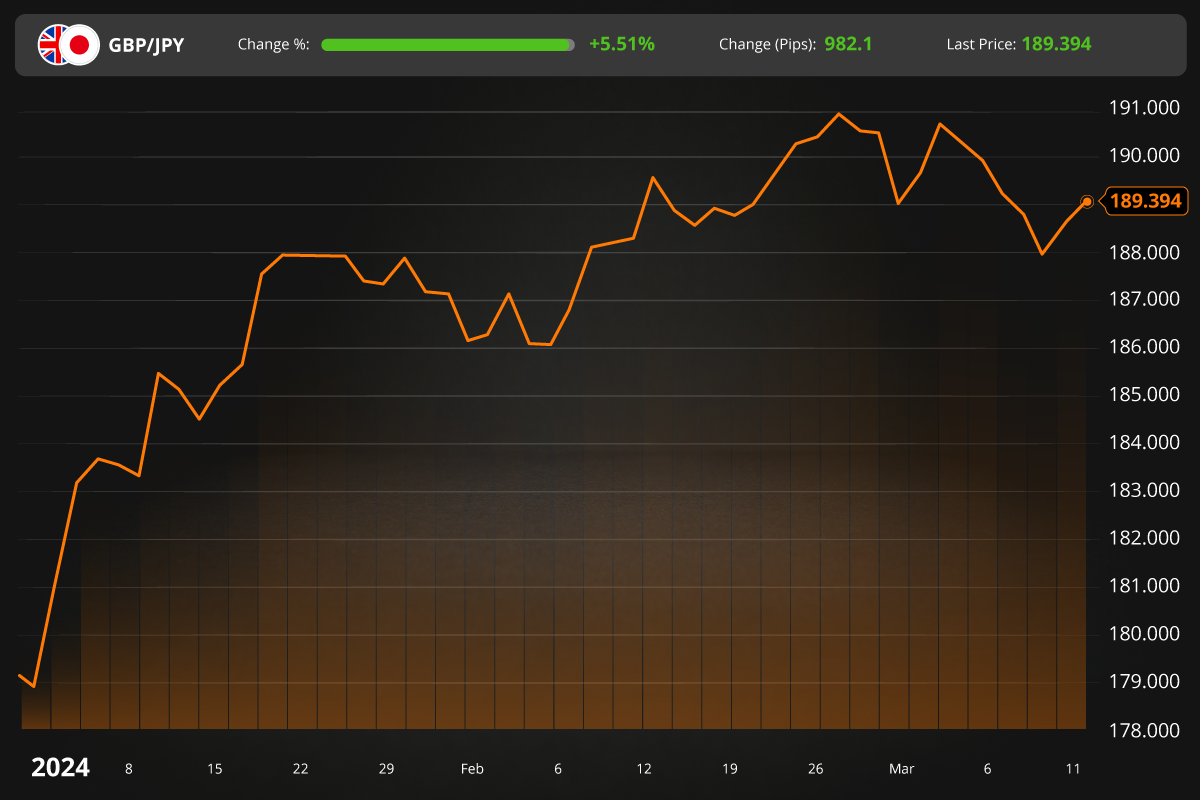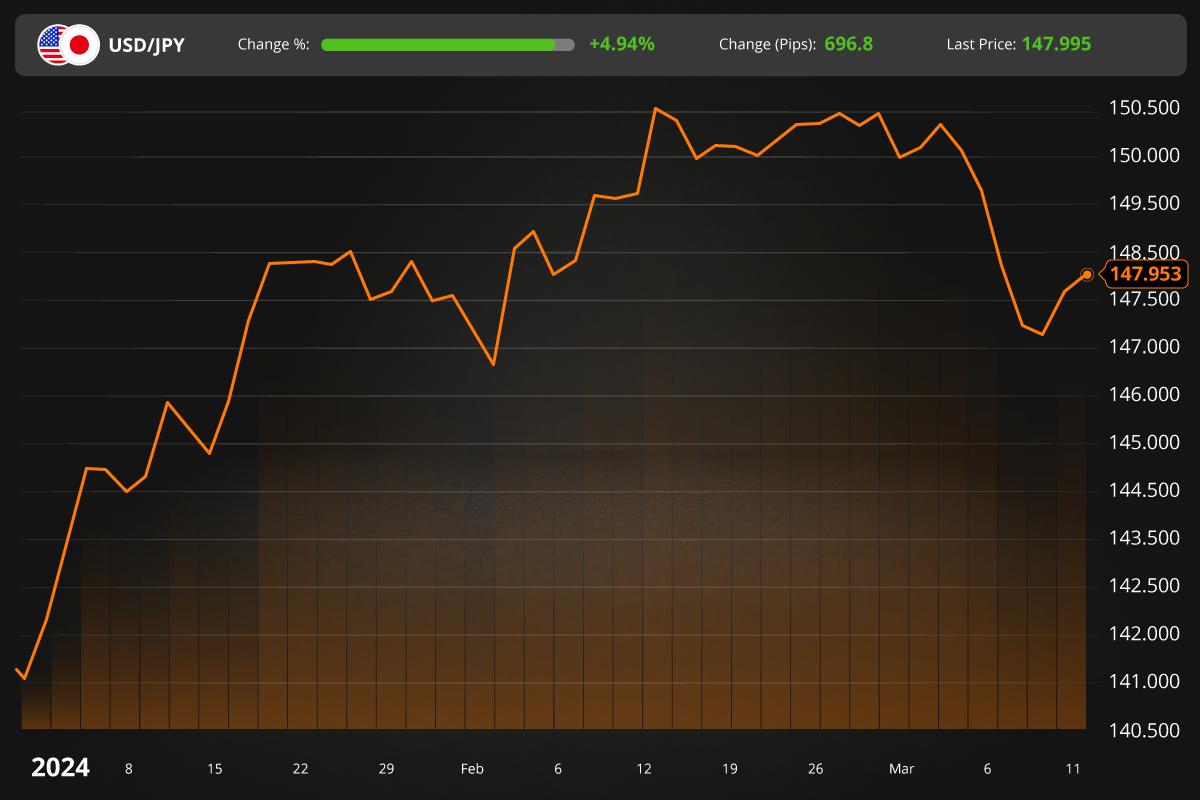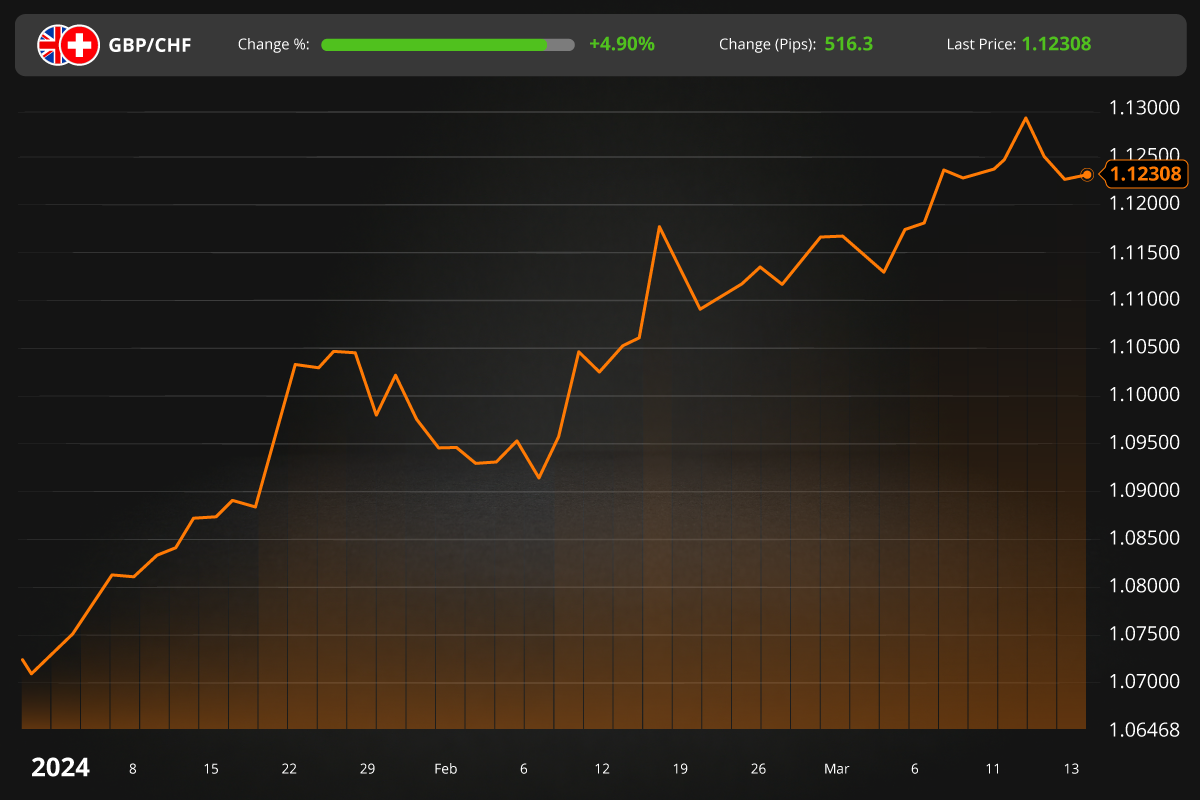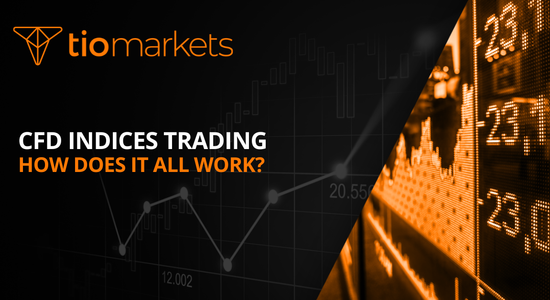3 Major Currency Pairs to Watch in 2024
BY TIO Staff
|März 13, 2024As we approach the end of the first quarter of 2024, 3 major currency pairs have emerged as market leaders with a noteworthy year-to-date performance.
At the time of this writing, they are:
- GBP/JPY (+5.51%)
- USD/JPY (+4.94%)
- GBP/CHF (+4.90%
These currency pairs have been on the rise since the beginning of the year but will they continue?
In this article, we'll delve into the 4 currencies that make up these 3 major currency pairs. We'll take a look at the fundamentals that have shaped their performance. As well as highlight the key indicators you should be paying close attention to, which could impact their trajectories in 2024.
Keep reading to learn more.
3 Major Currency Pairs to Watch in 2024
Currency pairs are the foundation of the foreign exchange market, representing the comparative value of one currency against another. Traders engage in forex trading by buying or selling one currency in exchange for another, to try and profit from fluctuations in exchange rates.
Each currency pair consists of a base currency and a quote currency, where the base currency is the one being bought or sold, and the quote currency is the one used to make the exchange.
In the forex market, currency pairs are categorized into major, minor, and exotic pairs based on their liquidity, trading volume, and global economic significance.
In this one, we will be looking at 3 major currency pairs that have the strongest year-to-date performance for 2024.
GBP/JPY (Great British Pound vs Japanese Yen)

The GBP/JPY currency pair emerges as the frontrunner among the top three currency pairs to keep an eye on in 2024, having already marked an impressive gain of 5.51% since the beginning of the year. Currently riding on a remarkable long-term uptrend, the pair stands out not only for its recent performance but also for the strong momentum it has maintained since March 2020.
Analyzing the journey of GBP/JPY, we notice a robust uptrend that began from the lows of 124.04 in March 2020, spiralling upwards to the impressive highs of 191.32 by February 2024. This amounts to a staggering gain of over 54% in nearly four years, a surge largely fuelled by the distinct economic developments in Great Britain and Japan, which has influenced the pair's trajectory.
Economic Fundamentals Influencing GBP/JPY
The British Economy
In the UK, the narrative has largely revolved around the aggressive stance of the Bank of England against a spiralling inflation rate, which hit an alarming peak of about 11% in 2022. The Bank of England's decisive response involved substantial interest rate hikes, aiming to steer the economy towards its 2% inflation target by 2024. Although this approach was largely successful in bringing down inflation, the UK economy dipped in to a recessionary in the second half of 2023. The GDP growth rate contracted for the last two consecutive quarters, only returning to growth in January of this year.
The Japanese Economy
Meanwhile, Japan's economic scenario paints a contrasting picture, with the Bank of Japan persistently adhering to a relaxed monetary policy characterized by negative interest rates, a policy stance in place since 2016. Despite Japan's real annual GDP growth rate surpassing Britain's in 2024 (1.9% versus 0.1%), the disparity in monetary policies has paved the way for the GBP/JPY's significant appreciation.
Trading Opportunities for GBP/JPY in 2024
Given this backdrop, the GBP/JPY currency pair presents enticing trading opportunities for 2024. Traders should note the pair's resilience and strong uptrend, which reflects the diverging economic paths and policies of Great Britain and Japan. For those looking to leverage this dynamic, the key will be to closely monitor the ongoing economic indicators and central bank policies, especially the interest rate differential that could further influence the pair's movement.
USD/JPY (United States Dollar vs Japanese Yen)

The USD/JPY finds its place as the second major currency pair on our list, with an impressive year-to-date performance of 4.94%. This currency pair, mirroring the GBP/JPY's robust up trend, has charted a remarkable long term climb since March 2020. However, some indications are there that it might be settling into a consolidation phase, which should be carefully observed.
With an uptrend that took flight from the lows of 101.18 in March 2020, the USD/JPY has soared to the highs of 152.70 by October 2022. This significant gain of over 50% in less than three years, also serves as a testament to the divergent monetary policies of the United States and Japan. As it laid the foundations for this currency pair's impressive and sustained ascent.
Economic Fundamentals Influencing USD/JPY
The United States Economy
The US economy has showcased its resilience by defying recession forecasts with a strong annual GDP growth rate in 2023, clocking in at 2.5%. A remarkable deceleration in inflation was witnessed thanks to the Federal Reserve's commitment to maintaining high interest rates. They peaked and remain at 5.5%, which is unmatched by any other major economy or currency. Despite this hawkish stance, consumer demand is thriving, underpinned by growth in consumer spending. The robust appeal of the US Dollar, buoyed by relatively sound economic indicators and high interest rate yields, should put the USD/JPY on any traders watch list.
We have already mentioned the fundamentals for the Japanese economy above.
Trading Opportunities for USD/JPY in 2024
Looking ahead, savvy traders might want to take notice of USD/JPY's current long term consolidation phase and watch for any signs of a potential breakout of the highs at 152.70. Alternatively, there may be opportunities to short if this price area continues to hold as resistance. Indications from both the Federal Reserve of the Bank of Japan regarding changes to interest rates will continue to play a critical role in influencing the future trajectory of this currency pair.
The USD/JPY's longstanding uptrend and the potent interest rate differential between the United States and Japan creates an intriguing narrative for forex traders in 2024.
GBP/CHF (Great British Pound vs Swiss Franc)

The GBP/CHF emerges as the third intriguing currency pair on our list, boasting an impressive year-to-date gain of 4.90%. This currency pair, reflecting a similar performance to the USD/JPY, is particularly interesting because it registers a significant long-term downtrend since 2007.
The recent price swing down from the highs of 1.3074 in April 2021, to the most significant recent low of 1.0173 in October 2022 shows the GBP/CHF has declined by more than 22%.
Could this impressive year-to-date performance continue or is it merely a retracement providing a selling opportunity before the resumption of the longer term trend?
The price action on the daily chart suggests that the currency pair may be in a consolidation phase for over a year now, which is a development that warrants monitoring.
Economic Fundamentals Influencing GBP/CHF
The Swiss Economy
Renowned for its stability, the Swiss Franc has a reputation as a safe-haven currency, backed by Switzerland's robust economic foundations, modest national debt and substantial gold reserves.
Over the last ten years, the Swiss National Bank has actively accumulated substantial reserves of Euros and US Dollars to bolster the Franc. Additionally, Switzerland has successfully managed to keep inflation low compared to other major economies at around 2.2%. Distinguishing the country as the only major economy to achieve its inflation targets throughout 2023.
With that being said, the State Secretariat for Economic Affairs (SECO) has recently projected the country's economic growth for 2024 to be well below average. Previous average growth rates have been around 1.8%, while the new forecast for 2024 is set at 1.1%. This downward revision is due to potential economic risks, including a possible slowdown in Switzerland's key trading partners, specifically Germany and China. These two countries combined share about a quarter of Switzerland's export volume.
On inflation, the SECO expects further decreases to 1.9% in 2024, which is likely positive news for the CHF.
We have already covered the fundamentals for the British economy above.
Economic Indicators to watch
To help you better assess the possible price trajectories of these major currency pairs in 2024. You should pay close attention to some key economic indicators and continue to monitor them alongside your technical analysis.
Here's a breakdown of the key indicators for any country’s economy.
Gross Domestic Product (GDP)
GDP is the broadest measure of a nation's economic activity, representing the total value of all goods and services produced over a specific time period. It’s the primary indicator used to gauge the economy's health and to compare productivity levels between different countries. A rising GDP signifies economic growth and prosperity, often leading to increased investor confidence, while a contracting GDP can signal economic turmoil.
Why it's important: GDP growth influences monetary policy decisions, interest rates and can drive changes in currency valuations. It's a composite signal of market opportunities and economic strength.
Inflation (CPI & PPI)
Inflation reflects the rate at which the general level of prices for goods and services are changing, which affects the purchasing power of a currency. Central banks attempt to limit inflation and the perception of inflation in order to keep the economy in balance.
Why it's important: Inflation can erode the value of currency and savings, affecting consumer spending and business investments. Central banks often adjust interest rates to manage inflation, they raise rates to try to lower inflation and increase rates to stimulate spending and economic activity.
Interest Rates
Interest rates are critical for any economy as they determine the cost of borrowing money. This is the main tool of central banks to affect consumer spending and influence economic activity.
Why it's important: Changes in interest rates can influence economic growth, inflation, currency valuation and overall market sentiment. For example, higher interest rates may help bring down inflation by encouraging consumers to save money. While lower rates may help encourage consumer spending and loans for investment to stimulate the economy.
Employment Rates
Employment rates measure the percentage of the labour force that is working and is a primary indicator of economic health. High employment rates typically equate to a robust economy, as more people working means more income to fuel spending and investment.
Why it's important: In general, higher employment means higher aggregate income, potentially increasing consumer confidence and spending, which fuels economic growth. Meanwhile, high unemployment can lead to reduced consumer spending and can cause social issues and economic issues.
Conclusion
The GBP/JPY, USD/JPY, and GBP/CHF stand out as significant currency pairs to watch in 2024. The GBP/JPY in particular, has strong long term bullish momentum, underpinned by significant economic disparities in Great Britain and Japan.
Similarly, the USD/JPY also presents impressive performance, hinting at potential trading opportunities from the significant interest rate differentials in the United States and Japan.
Meanwhile, the GBP/CHF offers a glimpse into the potential vulnerability of the Swiss economy and the possible impact on this currency pair's short to medium term trajectory.
As 2024 unfolds, keeping a close eye on the underlying economic narratives for these currency pairs will be key to navigating the markets successfully. Whether you decide to go with the historical bullish trend of GBP/JPY, monitoring the consolidation phase of the USD/JPY, or speculate on a counter trend trade in GBP/CHF, each presents unique challenges and opportunities.
As always, you should monitor the fundamental indicators, as well as the charts, to make better informed trading decisions.

Risk disclaimer: CFDs are complex instruments and come with a high risk of losing money rapidly due to leverage. You should consider whether you understand how CFDs work and whether you can afford to take the high risk of losing your money. Never deposit more than you are prepared to lose. Professional client’s losses can exceed their deposit. Please see our risk warning policy and seek independent professional advice if you do not fully understand. This information is not directed or intended for distribution to or use by residents of certain countries/jurisdictions including, but not limited to, USA & OFAC. The Company holds the right to alter the aforementioned list of countries at its own discretion.
TIOmarkets exclusively offers an execution-only service. The views expressed are for information purposes only. None of the content provided constitutes any form of investment advice. The comments are made available purely for educational and marketing purposes and do NOT constitute advice or investment recommendation (and should not be considered as such) and do not in any way constitute an invitation to acquire any financial instrument or product. TIOmarkets and its affiliates and consultants are not liable for any damages that may be caused by individual comments or statements by TIOmarkets analysis and assumes no liability with respect to the completeness and correctness of the content presented. The investor is solely responsible for the risk of his/her investment decisions. The analyses and comments presented do not include any consideration of your personal investment objectives, financial circumstances, or needs. The content has not been prepared in accordance with any legal requirements for financial analysis and must, therefore, be viewed by the reader as marketing information. TIOmarkets prohibits duplication or publication without explicit approval.

Related Posts
Trade responsibly: CFDs are complex instruments and come with a high risk of losing all your invested capital due to leverage.



